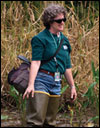|
Of Marsh & Mud on the Anacostia River
March 2010 • Volume 9, Number 1
Erica Goldman

Mudflats in the Anacostia River were fairly rare hundreds of years ago. Now they've all but replaced the historic marshes. How did this happen? more . . . |

Historical accounts of the Anacostia River describe extensive marshes, dense with wild rice, cattails, and reeds, lining a deep-water channel. The marshes were home to muskrat, beaver, and turtles. They were rich in bird life, with abundant kingfishers, herons, and Sora rails. Their waters teemed with shad, pike, perch, bass, and herring. Fishermen plucked giant sturgeon from the depths.
In the silted-in river of today, marshes have been replaced by barren mudflats with little vegetation. Researchers like Cairn Krafft, who are trying to restore those marshes, must overcome challenges created by an urban environment — pollution, runoff, trash — and with voracious geese. more . . .

Once a dumping ground for leaves and tree stumps, Kingman Island is now a restored urban park, with marshes, wildlife, and hiking trails. more . . . |

Howard University professor Charles Glass is working with local communities to keep trash out of the Anacostia River. more . . . |
|
|